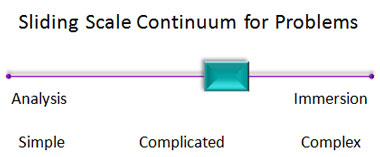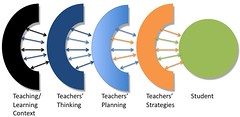The following signals a slight change in direction around the curriculum mapping project. First, the project is now going under the label “alignment project” (curriculum mapping is just one aspect of the project). Second, the project is likely to be re-framed as an application for an ALTC leadership grant. This post is an attempt to begin this re-framing. It’s really just thinking out loud.
As a result, I am very interested in suggestions and criticisms. In terms of suggestions, I’m particularly keen for insights onto better/alternative theoretical frames. It has become a bit confused as I’ve tried out different lines of approach.
Note: In the following a “course” typically means the smallest unit of teaching offered by an institution. A “program” is a group of courses that form a degree or perhaps a major.
Summary of the alignment project
Alignment is an increasingly core component of teaching in Australian universities. At a basic level, alignment is where the learning resources, learning activities and assessment of learning all align with the stated outcomes or aims of teaching (in a course/unit or program/course). Such alignment is a core component of various “movements” within university learning and teaching including: graduate attributes, quality assurance, and improvements in learning and teaching. However, consideration of alignment is not a regular, everyday part of teaching or learning at universities.
The majority of academic teaching practice involves the teaching of an existing course, one the academic has usually taught before, and as such most “teaching practice” revolves around making minor modifications to material or content (Stark, 2000). Academics are not often required to engage in the development of new courses or major overhauls of existing courses (Stark and Lowther 1988). Alignment is most considered during the development of new courses, major overhauls of existing courses or in response to external quality assurance needs.
The following two sub-sections try to summarise the alignment project. The first is a more concrete description, the second more abstract or theoretical. The thinking behind this project has changed many times, the following are likely to change. Suggest away.
Process and intent
As currently thought, the alignment project can be described as four main tasks:
- Modify Moodle to allow mapping of alignment.
Moodle has been chosen because it is the institutional e-learning system at both institutions that are part of the project. As such, support for Moodle is embedded into the institution and will continue to be supported. In addition, Moodle is an increasing part of the everyday practice of teaching academics. Lastly, Moodle, for a number of reasons, is very flexible and easy to modify and any modifications made could be usable by other institutions. The point of this project is not the Moodle modifications, it’s simply the best solution for embedding these changes into the institutions.
The changes will focus on enabling the alignment of outcomes (be the course learning outcomes, program learning outcomes, those from accrediting bodies, graduate attributes etc) with the assessment, activities and resources within a course site. Having this functionality is a foundation for the rest of the project.
- Work with teaching staff to map their courses.
Mapping the alignment of a course within Moodle is not going to be straight forward. Teaching staff are likely to be busy and may not be entirely familiar with the concepts around alignment and mapping. The content and design of a Moodle course site may not be currently appropriate in terms of developing a useful mapping of alignment. Using the alignment mapping functionality added to Moodle may not be straight forward.
For these and other reasons staff from the L&T support services will have to work collaboratively with academic staff to overcome these problems. This will be the first cycle of action research and will identify specific problems and insights into potential solutions.
- Work with teaching staff to embed alignment into everyday practice.
Once the initial mapping of alignment is complete, the focus moves onto helping academics maintain and reflect on the level of alignment within their course and programs. On helping them embed alignment considerations into everyday practice.
This is the second cycle of action research and will likely include the development of models, tools and processes that address questions such as:
- How do you encourage reflection and action based on the everyday consideration of alignment?
Identify the support, processes and tools do teaching academics and program leaders need to encourage and enable reflection and action?
- How do you measure and give feedback upon action based on the everyday consideration of alignment?
- Develop on-going and embedded institutional processes that take the lessons learned from the everyday consideration of alignment and use it to remove barriers within the institutional context.
Theoretical perspective
The alignment project is seeking to take the first steps towards what Biggs (2001) called the reflective institution. It seeks to do this by modifying the institutional systems around learning and teaching in ways suggested by Biggs (2001). These are:
- Make obvious the quality model.
Most institutions espouse the theory of alignment, however the teaching systems and processes employed by institutions do not make this theory explicit. The first step is to modify these systems so that a focus on alignment is made explicit as a part of every day teaching practice.
This is partly achieved through the modifications to Moodle to enable mapping of alignment. But more importantly it is achieved through the changes in L&T support, systems and processes that support academic in using those new Moodle capabilities. In part, these changes are the next step.
- Provide appropriate support for quality enhancement.
Further modify these systems and process to enable and encourage teaching staff to reflect and improve their teaching through a focus on alignment. The modifications build on the changes in the previous stage to enable this support to be highly contextualised to everyday teaching practice. A focus on helping in what academics do most often, the fine-tuning of existing courses.
- Inform the quality feasibility process.
Quality feasibility is the removal of factors in the teaching environment that are not conducive to good L&T. The everyday consideration of alignment will identify a range of barriers in the institutional setting, many of which will require the engagement of institutional leadership to remove.
ALTC leadership grants
The guidelines for the ALTC leadership grants scheme describe the grants as being for (my emphasis added)
projects that build leadership capacity in ways consistent with the promotion and enhancement of learning and teaching in contemporary higher education, and which reflect the ALTC’s values of excellence, inclusiveness, diversity and collaboration, and its commitment to long-term, systemic change.
The scheme has three priorities which can be summarised as being focused on: institutional leadership capacity building; disciplinary and cross-disciplinary leadership; and building on earlier projects. The alignment project seems to be best suited to Priority one
institutional leadership to enhance learning and teaching through leadership capacity-building at the institutional level.
- Funding range: $150,000 to $220,000
- Project duration: up to 2 years
In completing a lit review around leadership for the ALTC, Southwell and Morgan (2009) make the observation that
Leadership for Excellence in Learning and Teaching Program is expected to be a ‘demonstrable enhancement of learning and teaching through leadership capacity building’
What is leadership?
It seems required when discussing leadership to make the observation that “leadership eludes comprehensive definition” (Southwell and Morgan, 2009). Southwell and Morgan (2009) reference Marshall (2006) and Jameson (2006) as folk who have made that observation. Having made this claim, the idea is that you then define your familiarity with the broad array of perspectives, understandings and definitions of what leadership is. I’ll postpone that bit for now.
Southwell and Morgan (2009) draw on Leithwood and Levin (2005) who suggest that the core of most conceptions of leadership are two functions generally considered to be indispensable:
- Direction-setting: helping members of the organization establish a widely agreed on direction or set of purposes considered valuable for the organization; and
- Influence: encouraging organizational members to act in ways that seem helpful in moving toward the agreed on directions or purposes
Leithwood and Levin (2005) arrive at these two functions by adopting a definition where “the primary effect of organisational leadership would be significant change in a direction valued by the organisation”. In defending their definition or understanding of leadership, Leithwood and Levin (2005) agree that this may not be a precise definition, but that attempts to too narrowly define a complex topic like leadership is “more likely to trivialise than help bring greater clarity to its meaning”.
How the alignment project fits
Taking the emphasised phrases from the above purpose of the ALTC projects, I’d suggest/argue that the alignment project fits in the following ways:
- leadership capacity;
In terms of the above set of functions, the project is aiming to build into the systems and processes of each host institution the capacity to make consideration of alignment an every day part of practice. It helps establish a widely agreed direction for L&T and helps influence organisational members in moving towards that agreed direction.
- promotion and enhancement of L&T;
The educational literature is replete with evidence that consideration of alignment changes the conception of L&T held by academics and that it also results in improvements in student learning outcomes.
- contemporary higher education;
The project recognises and seeks to fulfill the increased requirements for accountability from a range of diverse source, however, it seeks to achieve it in a way that offers significant greater benefits that existing methods. As part of this the application seeks to engage with the on-going argument over centralised or devolved L&T support services by aiming for a focus on an approach to L&T support services that seeks to contextualise such support into the every day practice of teaching academics.
- inclusiveness, diversity and collaboration; and
The action research process suggested for use by the project is largely based on recognition within the project that engaging with the full diversity of higher education is essential. It recognises that this diversity will result in different approaches and benefits and that the process needs to enable this to happen. Similarly, collaboration is seen as essential to the project. Not just in the process used in this project, but in the aims of the project. An important aim of the project is to increase the collaboration around consideration of alignment in teaching.
- long-term, systemic change.
The project aims to embed consideration of alignment into the everyday practice of teaching staff. i.e. the aim of the project is long-term, systemic change. The process and approach being used is designed to achieve that aim.
The alignment project as leadership
Contemporary higher education is placing increasing importance on the concept of alignment in learning and teaching. In terms of quality assessment, program accreditation, graduate attributes and generally improving L&T alignment is broadly seen as a necessary component. However, many university courses are not all that well aligned and one explanation for this is that consideration and discussion of alignment is not a regular part of everyday teaching practice. Alignment is often only considered at the time of course and program reviews or accreditation.
The aim of the alignment project is to build leadership capacity into the system and processes of education within a university so as to encourage and enable effective and informed consideration of alignment as part of everyday teaching. This embedding of alignment into everyday practice then serves as the foundation for a range of other possibilities.
The alignment project is an example of leadership as it is attempting to encourage significant change – in the form of increased consideration of alignment at all levels – that is valued by the individual universities and the broader higher education sector. In addition, there is broad agreement in the education literature that alignment has significant positive effects on student learning outcomes.
The alignment project intends to fulfill the two indispensable functions of leadership identified by Leithwood and Levin (2005):
- direction-setting; and
By making considerations of alignment a visible and hopefully key aspect of everyday teaching, there should be an increased emphasis placed on learning outcomes, graduate attributes and other “outputs of learning”. This should encourage and assist academics teaching the same course or in the same program to increase discussion of these outcomes. To increase discussion of the purpose or direction of a course or program.
- influence.
A specific aim of the alignment project is to modify the teaching environment so that considerations, discussions and reflection upon alignment are directly encouraged and enabled. It encourages and enables them to think about how to move towards the stated directions or purpose.
Still not happy with that division. First attempt to make it concrete. Another query that arises from this is whether or not this project builds leadership capacity at two or more levels. For example, one approach is that it builds capacity at both the:
- Institutional level; and
At an institutional level it enables curriculum/program alignment, but also accountability etc.
- Instructional level.
This is the level between student and course/teacher. It makes alignment an more regular component of instruction.
Outcomes
If successful, the project should result in the consideration of alignment should becoming an every day component of teaching practice. This should/could generate the following outcomes:
- Changes in the conceptions of L&T held by teaching staff;
Being required to consider alignment encourages a different way of looking at teaching. This should encourage changes in the conceptions of L&T held by teaching staff towards those considered more appropriate.
- Improvements in student learning outcomes;
Effective considerations of alignment should increase the alignment within courses. The educational literature suggests that increases in alignment will result in improve student learning outcomes. In addition, it is likely that one of the likely additional outcomes will be making alignment more visible to students. Which should also encourage improved student learning outcomes.
- Improvements in the quality and timeliness of quality assurance; and
In terms of demonstrating alignment against outcomes or attributes, current quality assurance practices rely on special “mappings” that are held every few years. By embedding alignment considerations and mapping into every day teaching practice, the there is no longer any need for special “mappings”. “Mapping” information can be generated at any time as it is maintained as part of normal practice.
- A variety of additional outcomes.
Embedding alignment considerations as an everyday practice is the foundation of the project. The availability of “mapping” information and the on-going consideration of alignment will generate a range of additional outcomes. However, the diversity inherent in universities and higher education, combined with the fundamental change in everyday practice which this project aims to achieve means that it is unlikely we can predict successfully all of these outcomes.
Theoretical foundations
The ALTC place significant emphasis on applications having a sound and obvious theoretical base. The theoretical work that have informed my thinking about this project, and which may influence the project, include the following.
Project intent or outcome
Biggs (2001) presents an argument for a reflective institution that focuses on prospective, rather than retrospective quality. Having just re-read the paper, it seems to provide a good fit for a theory/model for the overall intent of the project.
The model is based on the idea of three aspects of AQ:
- Quality Model.
i.e. an espoused theory of teaching, for Biggs this is constructive alignment. For the alignment project this might be alignment a little more broadly.
- Quality enhancement.
A “teaching delivery system” that is designed in accordance to the quality model, i.e. one which encourages and enables alignments. In addition, the teaching delivery system should also have built-in mechanisms to continually review and improve current practice.
- Quality feasibility.
A process by which impediments to quality teaching are removed from the “teaching delivery system”.
The “quality model” is underpinned by a large, overlapping and diverse collection of literature from various areas including: outcomes-based quality/evaluation, instructional alignment (Cohen, 1987); curriculum alignment; graduate attributes; and, of course constructive alignment (Biggs and Tang, 2007; Biggs, 1999 ).
Understandings of universities and organisations
My personal conceptions of most organisations, but especially those like universities, are informed by Dave Snowden’s Cynefin framework and complex adaptive system.
Understandings of leadership
This is obviously an area which needs more consideration, beyond the summary given above.
Based on my limited reading, I like the description of “new leadership” (related to distributed leadership) attributed to Fullan (2008), which include:
- respect of employees, rather than simplistic judgmentalism;
A specific focus of this project is to help teaching staff consider the alignment of their courses. It is not to judge them. Biggs (2001) makes the point that under the type of reflective institution he outlines, the focus is on the teaching, not the teacher.
- connecting peers with purpose and ownership;
By embedding indications of alignment into the LMS the aim is to create connections between other teaching staff, academic leaders and also teaching support staff. The clear purpose is around considering alignment.
- building employees’ and systems capacity; and
This is the specific aim of the project. Building into the institution the capacity in both the employees and its systems to engage regularly in consideration of alignment.
- transparency of practice and results.
At the very least, the aim of this project is to enable teaching staff within the same program (i.e. group of courses/degree etc.) to see each others practice. To show what is aligned, where (or where not). It opens up the teaching practice to colleagues, hopefully in a way that is not judgmental.
Process
Based on some of the above and below, I’m leaning very much towards an action research process. The practice of L&T within a university is a complex-adaptive system. As we introduce change into the system, the system will change around us and unexpected event will happen. The type of change suggested involves a fairly widespread change in the practice of teaching academics, but also the institution. In addition, as far as I’m aware, no-one else has tried and reported on this type of change, hence it is novel. While driving towards a particular goal, we have to aim on learning as much as we can during the process.
In addition, Biggs (2001) offers the following
action research, a methodology designed precisely to generate and evaluate in-context innovations (Elliott 1991). As a result of engaging in action research, teachers change their conceptions of teaching, and teach more effectively (Kember 2000).
This type of approach also fits very closely with what is known about staff development.
i.e. the current recommendations are that staff development should be as contextualised as possible. My conception of how teaching staff would be helped to consider the alignment of their courses contains a very heavy assumption on contextualised staff development. In fact, the presence of alignment information and the transparency between courses is aimed at helping this support and development to be increasingly contextualised to the every day teaching practice of the teaching staff.
Teaching practice
One of the fundamental models/theories underpinning this project for me is the observations embodied in the following.
How academics design their teaching is not described by a rational planning model (Lattuca and Stark 2009). In part, this is because the dominant setting for academics is teaching an existing course, generally one the academic has taught previously. In such a setting, academics spend most of their time fine tuning a course or making minor modifications to material or content (Stark 2000). Academics are usually not often required to engage in the development of new courses or major overhauls of existing courses (Stark and Lowther 1988).
The practice of most academics does not separate planning from implementation, and rather than starting with explicit course objectives, starts with content (Lattuca and Stark 2009). In the absence of formally documented teaching goals, the actual teaching and learning that occurs is more in line with the teacher’s implicit internalised knowledge, than that described in published course descriptions (Levander and Mikkola 2009). Formal descriptions of the curriculum do not necessarily provide much understanding about how teachers put their curriculum ideas into action (Argyris and Schon 1974)
References
Argyris, C., & Schon, D. (1974). Theory in practice: Increasing professional effectiveness. Oxford, England: Jossey-Bass.
Biggs, J. (1999). Teaching for quality learning at university. Buckingham: Open University Press.
Biggs, J. (2001). The Reflective Institution: Assuring and Enhancing the Quality of Teaching and Learning. Higher Education, 41(3), 221-238.
Cohen, S. A. (1987). Instructional alignment: Searching for a magic bullet. Educational Researcher, 16(8), 16-20.
Fullan, M. (2008). The Six secrets of change. San Francisco: Jossey-Bass.
Jameson, J. (2006). Leadership in post-compulsory education: Inspiring leaders of the future. London: David Fulton Publishers.
Kember, D. (2000). Action Learning and Action Research: Improving the Quality of Teaching and Learning. London: Kogan Page.
Lattuca, L., & Stark, J. (2009). Shaping the college curriculum: Academic plans in context. San Francisco: John Wiley & Sons.
Levander, L., & Mikkola, M. (2009). Core curriculum analysis: A tool for educational design. The Journal of Agricultural Education and Extension, 15(3), 275-286.
Marshall, S. (2006). Issues in the development of leadership for learning and teaching in higher education (Occasional paper). Sydney: Carrick Institute of Learning and Teaching in Higher Education.
Stark, J. (2000). Planning introductory college courses: Content, context and form. Instructional Science, 28(5), 413-438.
Stark, J., & Lowther, M. (1988). Strengthening the Ties That Bind: Integrating Undergraduate Liberal and Professional Study. Ann Arbor, MI: Professional Preparation Project.
Southwell, D., & Morgan, W. (2009). Leadership and the impact of academic staff development and leadership development on student learning outcomes in higher education: A review of the literature. Sydney: Australian Learning and Teaching Council.



